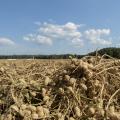Peanuts
Mid-Late-Season Water Needs in Peanut
Water is an issue that has been on everyone’s mind this year, and for many of us, it has not been our friend. It was wet early, keeping us from getting in the field for land preparation and planting. Since then, it seems like the only rain we’ve received has come in the form of popup storms. We haven’t had a true ‘rainy day’ all summer in most locations across the state. Having said that, we had a good early pod set and are still set up to have a decent crop, with potential for a good crop if the weather pattern shifts from this point forward.
Right now (August 10, 2015), a May 5th planted crop is at peak water use, using around 3/10 of an inch of water per day and slightly over two inches per week. Most of us haven’t received anything close to that lately. If rain does begin to pick up, the early wet conditions and resultant late planting could be a blessing in disguise, as a May 15th planted crop is still 1.5 weeks away from peak water use and a May 25t planted crop is still about three weeks away. For those that planted early, don’t abandon hope for big yields. The extreme non-determinate growth habit allows the crop to go through periods of stress and then rebound nicely when favorable conditions return. Keep in mind that depending on conditions, it typically takes 5-7 weeks for a peg that has just entered the soil to become a sound, mature kernel. We are still within a window that a late flush of pods could mean bigger yields at harvest.
From this point until harvest, we want to do our best to make sure the crop is not water limited. Peanuts are unique in that they use almost an inch of water per week right up until digging time. If you have the ability to irrigate, don’t terminate too early. For optimum yield potential, don’t let your crop become drought-stressed from now until the end of the season. Research from Georgia has shown that up to 30% of yield can be made in the last three weeks of the season. Having said that, soil moisture conditions must be right at digging time. Over-watering late, in addition to the ever-present chance of a wet fall, can spell trouble at harvest time. Big yield potential means nothing if we can’t get the crop out of the field. As always, don’t hesitate to call, especially as it gets closer to making harvest decisions. A large percentage of my fall is spent making harvest timing recommendations, and I’m always happy to do it.
Brendan Zurweller, Peanut Specialist, Mississippi State University
662-325-2311, brendan.zurweller@msstate.edu
Publications
News
STARKVILLE, Miss. -- Row crop producers who reported financial loss in 2024 may be eligible for economic assistance through a U.S. Department of Agriculture resource.
RAYMOND, Miss. -- Mississippi’s peanut producers are close to wrapping up harvest for 2024. Producers planted 25,500 acres of peanuts, a 30% increase from last year. This year, growers returned between 4,000 and 5,000 acres to peanut production.
Success Stories
Eupora producer earns national award
Billy Tabb got a reality check in 2003 when he told his father he wanted to farm.
“My dad is a lifelong farmer, so I was hoping he would help me get started. He told me to go to the FSA office and get a loan,” Tabb recalls. “When I got there, the lender gave me a stack of papers as thick as the Bible and wished me good luck.”
Lonnie Fortner was the first row-crop producer in southwest Mississippi to use many of the same precision ag technologies that are now commonplace.





